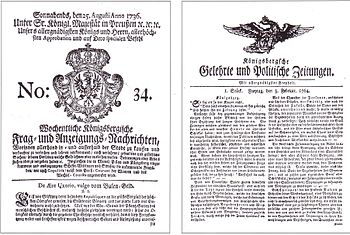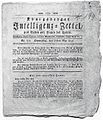Koenigsberg newspapers
The Königsberg newspapers were newspapers in the Duchy of Prussia , in the Kingdom of Prussia and in the province of East Prussia . Always politically and culturally involved, they were of national importance. They gave important impulses for the liberal and democratic development of Germany. In “conservative East Prussia” they stood for its provincial capital as a “liberal stronghold of an educated, republican, west-oriented bourgeoisie” (Manthey 2005).
meaning
Closely related to the major parties, three newspapers have long enjoyed a high reputation:
- Königsberger Allgemeine Zeitung ( German People's Party )
- Hartungsche Zeitung ( German Democratic Party )
- Ostpreußische Zeitung ( German National People's Party )
“Hardly any other German newspaper [like the KAZ] is likely to have found its way through all social classes on such a scale. The liberal "Hartungsche Zeitung" also received attention, but least of all the agrarian conservative "Ostpreußische Tageblatt", which only came to the fore after 1918. Of the foreign newspapers, the old “Daily Rundschau” exercised the greatest influence. "
The editions of the three newspapers up to 1945 have largely been preserved in the Berlin State Library ( Stiftung Preußischer Kulturbesitz ). In many ways, they are prime sources.
history
17th and 18th centuries
In 1618 Johann Fabricius printed the first, but irregularly published “Königsberger Zeitung” . In 1623 Lorenz Segebade published the first weekly newspaper "Avisen" . In 1639, Elector Friedrich Wilhelm brought Johann Reussner from Rostock to Königsberg as an academic printer, who continued the Segebadsche Zeitung with his own printing works. After censorship was introduced in Königsberg in 1657 , Reussner received the privilege for the "European Mercurius", which appears twice a week .
The successor was the “Ordinari Postzeitung” with Reussner's sons.
In the Königsberg century in 1709 Reussner published the “Kgl. Prussia. Fama " , 1727 the " intelligence sheet "of the Kgl. Address Comtoirs. Johann Heinrich Hartung followed in 1742 .
In 1752 Hartung brought the “Kgl. privilege. Pr. Staats-, Krieges- und Friedenszeitungen ” , which from 1850 to 1933 gained a great reputation as the “ Hartungsche Zeitung ” . The second version appeared in 1810, Der Correspondent .
19th century
In 1849 conservatives founded the Ostpreußische Zeitung .
In 1875 Hausbrandt founded the Communalblatt for Königsberg and the Province of East Prussia , which in 1882 became the Königsberger Allgemeine Zeitung .
In 1892 the "Königsberger Volkstribüne" appeared , in 1897 the "Königsberger Tageblatt" by Hartung.
20th century
The Königsberger Anzeiger appeared as a non-party daily newspaper from 1900. Initially under the name Königsberger Latest News it was published by the East Prussian printing and publishing house .
From 1901 to 1933 the Königsberger Volkszeitung , the social democratic daily newspaper, appeared with six issues per week. As of 1939, Königsberg only had three daily newspapers:
literature
- Jürgen Manthey : newspaper town Königsberg (Alexander Jung, Ferdinand Gregorovius, Wilhelm Jordan, Ludwig Walesrode) , in this: Königsberg. History of a world citizenship republic . Munich 2005, ISBN 978-3-423-34318-3 , pp. 461-477.
- Herbert Meinhard Mühlpfordt : Königsberg from A to Z. A city dictionary. Munich 1972, ISBN 3-7612-0092-7
- Botho Rehberg: History of the Königsberg newspapers and magazines . Königsberg (Pr.) 1942
Web links
- Digitized KAZ
- The Avisen or weekly newspaper from the year 1623 published in Königsberg digitally in the State and University Library Bremen
- German-Russian Königsberger Allgemeine (2009)
- Historical newspapers
- Festschrift 100 years of KAZ
Remarks
- ^ The editors-in-chief of the Ostpreußische Zeitung were among others Paul Anton (1887–1897) and Eduard Kenkel in the Weimar Republic
- ^ Emil Popp: On the history of the Königsberg student body 1900-1945 . Würzburg 1955 (new edition: WJK, Hilden 2004, p. 46, ISBN 3-933892-52-X )
- ↑ Hans Parlow's novel “Dunkelrot-Weiß-Rosenrot” appeared in the Tälichen Rundschau around 1911 . He plays in the circles of the fraternity Germania Königsberg , of which the author had been a member for several semesters since 1876. It remained the only student novel in Königsberg.
- ↑ Some numbers of the European Mercury have been preserved.
- ↑ In 1680 a Reussner was fined 20 thalers for calling the Russians beasts in a journal.
- ↑ There was great indignation and government intervention in 1743 when an Abraham Müller offered six people for sale in the newspaper.



